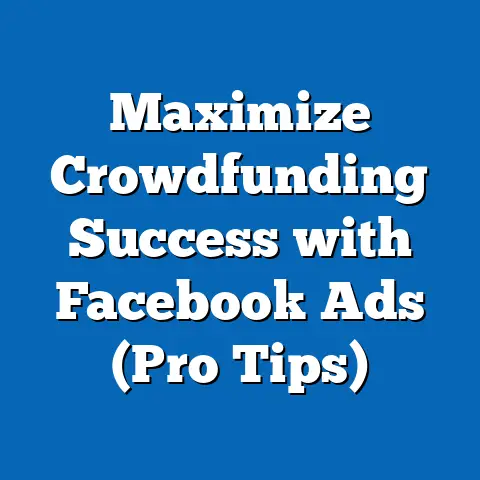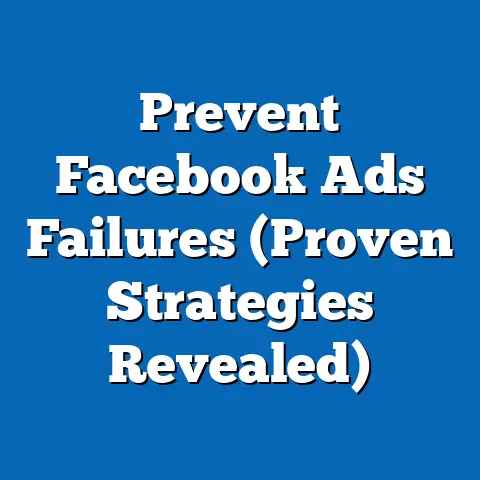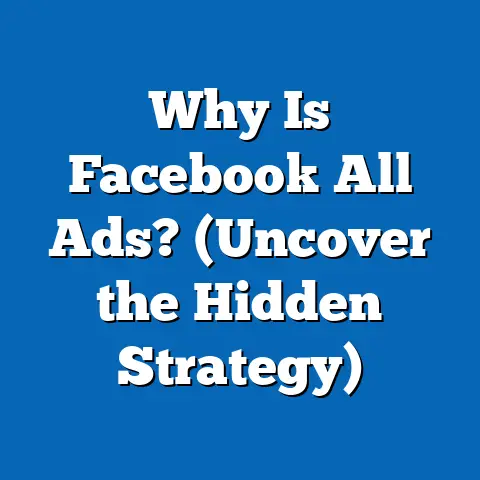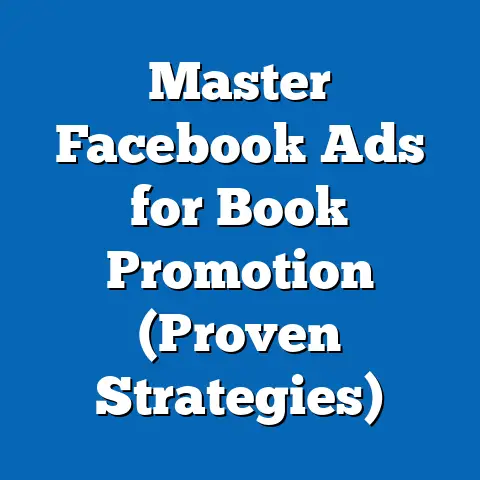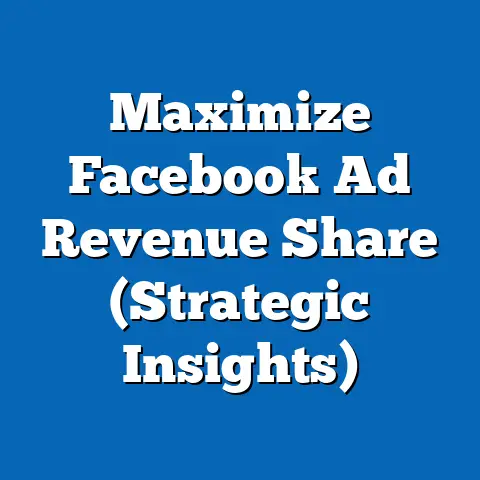Unlock 7 Key Facebook Ad Metrics (Essential for BigCommerce Success)
As an e-commerce entrepreneur, I’ve learned that success isn’t just about having a great product; it’s about understanding how to get that product in front of the right people, at the right time, and at the right price. In the world of online retail, the concept of “resale value” isn’t just about tangible goods; it’s also about the value you create through effective marketing and brand building. And in today’s digital landscape, Facebook advertising is a critical tool for driving sales and enhancing that perceived value.
I’ve seen firsthand how a well-executed Facebook ad campaign can transform a struggling BigCommerce store into a thriving online business. But here’s the thing: you can’t just throw money at Facebook and hope for the best. You need to be strategic, data-driven, and relentlessly focused on measuring your results. That’s where Facebook ad metrics come in. They’re your compass, guiding you towards profitable campaigns and away from wasteful spending.
I’m going to walk you through seven essential Facebook ad metrics that can unlock BigCommerce success. These metrics aren’t just numbers; they’re insights into your customer’s behavior, your campaign’s performance, and the overall health of your business. By understanding and leveraging these metrics, you can make informed decisions, optimize your ad spend, and ultimately, grow your BigCommerce store. Let’s dive in!
Understanding Facebook Ad Metrics
Facebook ad metrics are the lifeblood of any successful e-commerce advertising strategy. They provide a quantifiable way to measure the performance of your campaigns, allowing you to understand what’s working, what’s not, and where you need to make adjustments. For BigCommerce businesses, these metrics are particularly crucial because they directly impact your bottom line.
I like to think of Facebook ad metrics as falling into two broad categories: quantitative and qualitative. Quantitative metrics are the hard numbers – clicks, impressions, conversions, and revenue. These are the metrics you can easily track and analyze using Facebook Ads Manager. Qualitative metrics, on the other hand, are more about the “why” behind the numbers. They involve understanding customer sentiment, brand perception, and the overall user experience.
I’ve discovered that a combination of both quantitative and qualitative metrics is essential for a holistic understanding of your Facebook ad performance. For example, a high click-through rate (CTR) might indicate that your ad creative is engaging, but if your conversion rate is low, it could mean that your landing page isn’t delivering on the promise of your ad.
By tracking and analyzing these metrics, you gain invaluable insights into customer behavior, campaign performance, and overall business health. You can identify your most profitable audiences, refine your ad creative, optimize your bidding strategies, and ultimately, maximize your return on investment (ROI).
Key Takeaway: Facebook ad metrics are essential for understanding the performance of your campaigns and making data-driven decisions to improve your results. Focus on both quantitative and qualitative metrics for a holistic view.
Metric 1 – Click-Through Rate (CTR)
Click-Through Rate (CTR) is a fundamental metric that measures the percentage of people who see your ad and then click on it. It’s calculated by dividing the number of clicks your ad receives by the number of times it’s shown (impressions), expressed as a percentage.
CTR = (Clicks / Impressions) x 100%
I’ve found that CTR is a powerful indicator of how well your ad creative resonates with your target audience. A higher CTR suggests that your ad is visually appealing, relevant, and compelling enough to entice people to click and learn more.
Here’s why CTR is so important:
- Relevance: A high CTR indicates that your ad is relevant to the interests and needs of your target audience.
- Engagement: It shows that your ad is capturing attention and generating interest.
- Quality Score: Facebook uses CTR as a factor in determining your ad’s quality score, which can impact your ad’s ranking and cost.
I remember one campaign I ran for a BigCommerce client selling handmade jewelry. We initially had a CTR of around 0.5%, which was below average for the industry. After analyzing the data, we realized that our ad creative wasn’t effectively showcasing the unique craftsmanship and artistry of the jewelry. We revamped the ads with high-quality images, compelling storytelling, and a clear call to action. The result? Our CTR jumped to 2.5%, and our sales skyrocketed.
Analyzing CTR can help you refine your targeting and messaging strategies. If you see a low CTR, consider the following:
- Is your ad creative visually appealing? Use high-quality images or videos that capture attention.
- Is your ad copy relevant to your target audience? Speak to their interests, needs, and pain points.
- Is your call to action clear and compelling? Tell people exactly what you want them to do.
Key Takeaway: CTR is a critical metric for measuring the effectiveness of your ad creative. A higher CTR indicates that your ad is relevant, engaging, and visually appealing to your target audience.
Metric 2 – Cost Per Click (CPC)
Cost Per Click (CPC) measures the average amount you pay each time someone clicks on your ad. It’s calculated by dividing your total ad spend by the number of clicks your ad receives.
CPC = Total Ad Spend / Clicks
From my experience, CPC is a vital metric for budget management in Facebook ad campaigns. It directly affects your overall marketing costs and profitability. Understanding your CPC allows you to compare the performance of different ad sets and optimize your bidding strategies.
Here’s why CPC is so important:
- Budget Control: Monitoring CPC helps you stay within your advertising budget.
- Profitability: Lowering your CPC can increase your profitability by reducing your acquisition costs.
- Efficiency: Comparing CPC across different ad sets allows you to identify the most efficient campaigns.
I once worked with a BigCommerce store selling eco-friendly cleaning products. Their initial CPC was relatively high, around $1.50 per click. We analyzed their targeting and discovered that they were targeting a broad audience with generic messaging. We refined their targeting to focus on specific demographics and interests, such as environmentally conscious consumers and families with young children. We also created more targeted ad copy that highlighted the unique benefits of their products, such as their natural ingredients and eco-friendly packaging. As a result, their CPC dropped to $0.75 per click, and their sales increased significantly.
Several factors can influence your CPC, including:
- Competition: The more advertisers targeting the same audience, the higher the CPC.
- Ad Quality: Facebook rewards high-quality ads with lower CPCs.
- Bidding Strategy: Your bidding strategy can impact your CPC.
- Targeting: More specific targeting can lead to lower CPCs.
Key Takeaway: CPC is a crucial metric for budget management and profitability. Lowering your CPC can increase your ROI and allow you to reach more customers with your advertising budget.
Metric 3 – Conversion Rate (CR)
Conversion Rate (CR) measures the percentage of people who click on your ad and then complete a desired action, such as making a purchase, signing up for an email list, or filling out a form. It’s calculated by dividing the number of conversions by the number of clicks, expressed as a percentage.
CR = (Conversions / Clicks) x 100%
From what I’ve seen, CR is a key metric for measuring the effectiveness of your ads in driving sales on BigCommerce platforms. It reflects how well your ads are converting clicks into customers. A higher CR indicates that your ads are not only attracting the right people but also delivering a compelling experience that leads them to take action.
Here’s why CR is so important:
- Sales Performance: CR directly impacts your sales revenue and overall profitability.
- Ad Relevance: It indicates how well your ad aligns with the user’s intent and expectations.
- Landing Page Experience: CR is influenced by the quality and relevance of your landing page.
I had a client who was running Facebook ads for their BigCommerce store, which sold high-end coffee beans. They were getting a decent amount of clicks, but their conversion rate was abysmal, around 0.5%. After digging deeper, we discovered that their landing page was slow, poorly designed, and didn’t provide enough information about their products. We completely redesigned their landing page, optimizing it for speed, clarity, and user experience. We also added high-quality images, detailed product descriptions, and customer testimonials. The result? Their conversion rate jumped to 3%, and their sales exploded.
Several factors can influence your conversion rate, including:
- Ad Relevance: Ensure your ad copy and creative align with the user’s search intent.
- Landing Page Experience: Optimize your landing page for speed, clarity, and user experience.
- Product Quality: Offer high-quality products that meet the needs and expectations of your customers.
- Pricing: Ensure your pricing is competitive and offers good value for money.
Key Takeaway: Conversion Rate is a critical metric for measuring the effectiveness of your ads in driving sales. Optimizing your ads and landing pages for conversion can significantly increase your revenue and profitability.
Metric 4 – Return on Ad Spend (ROAS)
Return on Ad Spend (ROAS) measures the revenue generated for every dollar spent on advertising. It’s calculated by dividing your total revenue generated from ads by your total ad spend.
ROAS = Total Revenue from Ads / Total Ad Spend
In my opinion, ROAS is a critical metric for evaluating the financial success of Facebook ad campaigns. It provides a clear picture of how well your advertising investments are paying off. A higher ROAS indicates that your ads are generating more revenue for every dollar spent.
Here’s why ROAS is so important:
- Profitability: ROAS directly impacts your profitability and overall business growth.
- Budget Allocation: It helps you allocate your advertising budget to the most profitable campaigns.
- Campaign Optimization: ROAS guides your campaign optimization efforts, helping you identify areas for improvement.
I once worked with a BigCommerce client selling custom-printed t-shirts. They were running multiple Facebook ad campaigns, but they weren’t sure which campaigns were the most profitable. We tracked their ROAS for each campaign and discovered that their campaigns targeting specific niches, such as pet lovers and gamers, had a significantly higher ROAS than their broader campaigns. We shifted their budget allocation to focus on these high-performing campaigns, and their overall ROAS increased dramatically.
What constitutes a good ROAS for BigCommerce businesses? It depends on your industry, product margins, and business goals. However, a general rule of thumb is that a ROAS of 3:1 or higher is considered good. This means that for every dollar spent on advertising, you’re generating at least three dollars in revenue.
Key Takeaway: ROAS is a crucial metric for evaluating the financial success of your Facebook ad campaigns. Aim for a ROAS of 3:1 or higher to ensure your advertising investments are generating a positive return.
Metric 5 – Frequency
Ad frequency refers to the average number of times a person sees your ad. It’s calculated by dividing the total number of impressions by the reach of your campaign.
Frequency = Impressions / Reach
I’ve learned that frequency is an important metric to monitor because it can impact ad performance in both positive and negative ways. While some level of repetition is necessary to build brand awareness and drive conversions, too much frequency can lead to ad fatigue, where people become annoyed or indifferent to your ads.
Here’s why frequency is so important:
- Brand Awareness: A certain level of frequency is necessary to build brand awareness and recognition.
- Ad Fatigue: High frequency can lead to ad fatigue, resulting in lower engagement and conversion rates.
- Cost Efficiency: Monitoring frequency helps you optimize your ad spend and avoid wasting money on over-exposure.
I remember a campaign I ran for a BigCommerce client selling organic skincare products. We initially had a low frequency, around 1.5, and our ads were performing well. However, as we scaled the campaign, our frequency started to creep up, eventually reaching 4. Our engagement and conversion rates started to decline, and we realized that people were getting tired of seeing our ads. We implemented a few strategies to reduce our frequency, such as refreshing our ad creative, expanding our targeting, and using frequency capping. As a result, our engagement and conversion rates rebounded, and our campaign performance improved.
Here are some tips for managing ad frequency:
- Refresh your ad creative regularly: Keep your ads fresh and engaging by updating your images, videos, and copy.
- Expand your targeting: Reach new audiences by expanding your targeting parameters.
- Use frequency capping: Limit the number of times a person sees your ad within a specific timeframe.
- Monitor your frequency: Track your frequency metric closely and make adjustments as needed.
Key Takeaway: Frequency is an important metric to monitor because it can impact ad performance in both positive and negative ways. Keep your frequency in check to avoid ad fatigue and optimize your ad spend.
Metric 6 – Return on Investment (ROI)
Return on Investment (ROI) measures the overall profitability of your Facebook advertising efforts. It takes into account all costs associated with your campaigns, including ad spend, production costs, and agency fees, and compares them to the revenue generated.
ROI = (Net Profit / Total Investment) x 100%
I’ve found ROI to be the ultimate metric for evaluating the success of your Facebook advertising strategy. While ROAS focuses specifically on the revenue generated from ad spend, ROI provides a more comprehensive view of your overall profitability.
Here’s why ROI is so important:
- Overall Profitability: ROI measures the overall profitability of your advertising efforts.
- Strategic Decision-Making: It informs your long-term business decisions and helps you allocate resources effectively.
- Performance Evaluation: ROI provides a benchmark for evaluating the performance of your advertising strategy.
I once worked with a BigCommerce client selling handmade furniture. They were running Facebook ads, but they weren’t sure if their advertising efforts were actually profitable. We calculated their ROI, taking into account their ad spend, production costs, and agency fees. We discovered that their ROI was relatively low, around 10%. After analyzing their campaign performance, we identified several areas for improvement, such as optimizing their targeting, improving their ad creative, and streamlining their production process. As a result, their ROI increased to 30%, and their business became significantly more profitable.
The difference between ROI and ROAS is that ROI takes into account all costs associated with your advertising efforts, while ROAS focuses solely on the revenue generated from ad spend. Both metrics are important, but ROI provides a more comprehensive view of your overall profitability.
Key Takeaway: ROI is the ultimate metric for evaluating the success of your Facebook advertising strategy. Focus on maximizing your ROI to ensure your advertising efforts are generating a positive return.
Metric 7 – Customer Lifetime Value (CLV)
Customer Lifetime Value (CLV) predicts the total revenue a customer is expected to generate throughout their relationship with your business. It takes into account factors such as average purchase value, purchase frequency, and customer retention rate.
While CLV isn’t a direct Facebook ad metric, I’ve learned that it’s incredibly valuable for understanding the long-term value of customers acquired through Facebook ads. By understanding your CLV, you can make more informed decisions about your ad spending and focus on strategies that maximize customer retention.
Here’s why CLV is so important:
- Ad Spending Decisions: CLV informs your ad spending decisions and helps you determine how much you can afford to spend to acquire a new customer.
- Customer Retention: It highlights the importance of retaining customers for maximizing profits.
- Targeted Advertising: CLV can be used to segment your audience and target high-value customers with personalized ads.
I once worked with a BigCommerce client selling subscription boxes for pet owners. They were running Facebook ads to acquire new customers, but they weren’t tracking their CLV. We implemented a system to track their CLV and discovered that their average customer had a lifetime value of $500. This information allowed them to make more informed decisions about their ad spending. They realized they could afford to spend more to acquire new customers because they knew they would recoup their investment over time. They also started focusing on strategies to increase customer retention, such as offering loyalty rewards and personalized recommendations.
Here are some strategies for enhancing CLV through targeted ads:
- Upselling and Cross-selling: Promote related products or services to existing customers.
- Loyalty Programs: Offer exclusive rewards and discounts to loyal customers.
- Personalized Recommendations: Recommend products or services based on customer preferences and purchase history.
- Customer Service: Provide excellent customer service to build strong relationships with your customers.
Key Takeaway: CLV is a valuable metric for understanding the long-term value of customers acquired through Facebook ads. Focus on strategies that maximize customer retention and increase CLV to boost your overall profitability.
Conclusion
Understanding and leveraging these seven key Facebook ad metrics is essential for achieving success on BigCommerce. Each metric provides valuable insights that can help you make informed decisions, optimize your ad spend, and ultimately, grow your e-commerce business.
I’ve shown you how CTR, CPC, Conversion Rate, ROAS, Frequency, ROI, and CLV each contribute to making informed decisions that can enhance profitability, customer satisfaction, and overall business growth. By continually monitoring these metrics, you can refine your advertising strategies and improve your e-commerce performance.
Remember, Facebook advertising is an ongoing process of testing, learning, and optimization. Don’t be afraid to experiment with different ad creative, targeting strategies, and bidding strategies to find what works best for your business. And always keep a close eye on your metrics to ensure you’re on track to achieve your goals.
Call to Action
Now it’s your turn! I encourage you to analyze your current Facebook ad metrics and consider implementing the insights from this article to unlock your BigCommerce success. Start tracking these metrics, experiment with different strategies, and see how they can transform your advertising results. Your BigCommerce success story starts now!

